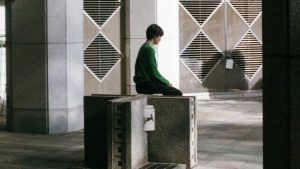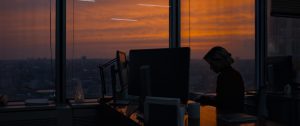The cinema experience is pleasure and pain at the same time
One cannot but feel at home at the Viennale. For a true cinephile it’s like coming back home after a long journey in the cold of instrumentalised, ideological cinema and adrenaline-fueled, muscular blockbusters. When after a 40 minutes Q&A with Japanese translation the auditorium is still full, or when the smiling cashier seems to have already watched all the films one has booked, this festival feels like it’s the place to be – a place that celebrates cinema as a shared experience.
The Japanese film I am referring to is Following the Sound (Kanata no uta, 2023) by Kyoshi Sugita, probably the most intriguing discovery of my Vienna journey. Elliptical like Angela Schanelec’s cinema – that was celebrated not only with the screening of her last film Music, but also with a publication (as part of the Viennale book series) – this is a cinema where the thin lines of a possible understanding are submerged by open scenes that work as brush strokes, all together painting an undefined but precise emotional tableau.

These filmic tableaux are an invitation to a journey into the unknown. From such journeys we can get a complex picture of reality, whose cinematic intensity will guarantee a permanent engraving in our mind, like in Frederick Wiseman’s Menus plaisirs – Les Troisgros (2023) or Wang Bing’s exceptional Youth – Spring (Qingchun, 2023). These films are cinema marathons for the viewer – both with a running time of around four hours – contrary to the one-hour long Allensworth, by James Benning. However, what Benning’s film shares with them is the same pleasure, both inquisitive and contemplative, for a territorial discovery that equally works as the representation of a world. Let’s say, “geographic cinema”, in the highest sense of geography.
I’m mentioning three renowned masters here, but at least three younger filmmakers provided us with equally strong exploratory experiences at this year’s Viennale. With their films we switch from geography to cosmology, also thanks to the overt existential vibe that animates them. I’m thinking of Bas Devos’ Here (2023), Pham Thien An’s Inside the Yellow Cocoon Shell (Bên trong vo kén vàng, 2023), and Eduardo Williams’ The Human Surge 3 (El auge del humano 3, 2023). In these three films, the cosmic breath of their narration goes together with concrete, simple, terrestrial walking, a rare and inspiring combination.
“Sigue adelante”, keep going: this is the immanent motto that haunts Eduardo Williams’ latest film. Not only do the protagonists of The Human Surge 3 never stop walking, but Williams’ camera is almost constantly walking, too. And we walk with them, because the camera moves at human speed. Through the camera, we follow a line that crosses Peru, Sri Lanka and Taiwan, a line that is perfectly continuous thanks to the “realisticoneiric” complicity of this penumbra that already characterised the Argentine director’s previous films, a penumbra that realises daydreaming as a sensory presence.

In reality, it is a camera within a camera: Williams films inside a first edited version of his film or, more precisely, it is in a headset that he records his own exploration of images previously shot with a 360-degree camera. What we see, then, is the exploration of a global territory, between America and Asia, but also the exploration of the globality to which the new filming technology gives us access – the global geography was anticipated by his previous film The Human Surge (El auge del humano, 2016), and the technological device was in turn anticipated by the experimental work Parsi (with Mariano Blatt, 2018).
If cinema has always been driven by the desire to see more, to see better – and not just to represent – then Williams’ film embodies this desire to the full. It is not a question of seeing everything (in a central, almost didactic scene, we are surprised by the abyss of abstraction that seeing everything would imply), but of assuming the propensity to see everything that technology offers us in order to stage the act of seeing itself, the exploratory act of seeing, in its apparently spontaneous state – where hallucination and observation merge. If there is a panopticon of surveillance and control, The Human Surge 3 rather exemplifies the panopticon of discovery, a discovery of wonder, where the all-seeing of the panopticon (360-degree camera) is merely a starting point for a free diversion into the unknown.
That said, following the rhythm of the human walk on one side, and vision as an act of exploration on the other, are two elements of a cinematic language that is also, and literally, driven by a third fundamental element: the human relationship, where friendship and complicity prevail on any potential conflict. Young people suddenly fall victim to narcolepsy or fly higher than mountain peaks, but above all they seek each other out, cross paths and walk together: The Human Surge 3 weaves the uneventful tale of a group of friends with polyglot harmony and no gender polarity – figures from a peaceful and restless Eden.
Brotherhood and sisterhood animate the dialogues, which are almost always far from the camera’s point of view, and which are also often far from our understanding. A text with enigmatic ellipses is superimposed onto the spoken word of everyday life, which I like to read as a poetic rewriting of a small talk that actually is small and dizzying at the same time. It’s not a question of understanding, of com-prehension (taking everything in), but of examining the void, the invisible.
Experience – and the experience of which cinema in particular is capable – is pain and pleasure at the same time; rarely does a film express the fusion of the two like this one. But it’s also a fusion of restlessness and calm that is characteristic of all exploration, where the path remains open to the encounter with the unexpected.
Giuseppe Di Salvatore
Edited by Pamela Jahn
© FIPRESCI 2023
